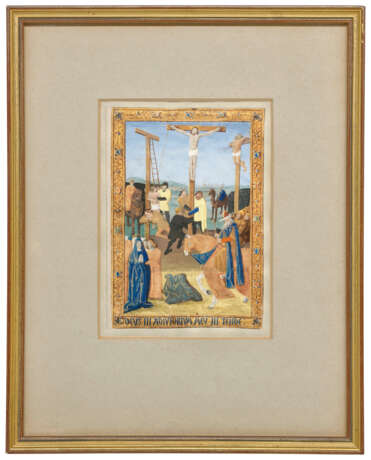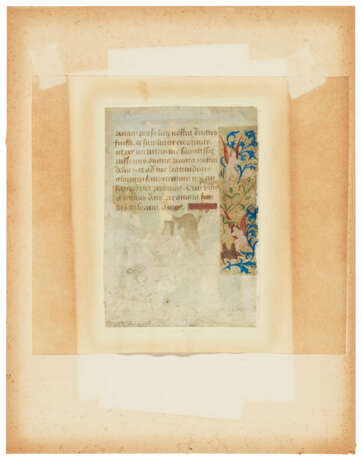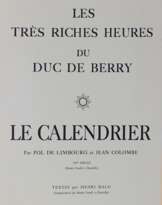ID 993147
Lot 19 | Jean Colombe (1430-1493)
Estimate value
£ 12 000 – 18 000
The Crucifixion, full-page miniature from an illuminated manuscript Book of Hours on vellum [France, Bourges, c.1470–75]
A splendid example of some of the most delicate work of Jean Colombe, with a sister leaf from the same manuscript at the Louvre in Paris.
136 x 93 mm, single leaf, ruled for 16 lines, the recto with the end of Terce, from ‘penam pro salute nostra […]’, with a panel border incorporating winged putti, the verso with a full page miniature, comprising Sext in the Hours of the Passion, the reverse inscribed in modern pencil ‘17’ (tiny losses of pigment to the sky and to the face and body of the crucified thief, else in excellent condition). Mounted and framed.
Provenance:
(1) ? John Boykett Jarman (1782–1864): the present miniature was copied by Caleb Wing, suggesting that the original may have belonged to Jarman, although it cannot be confidently identified in his 1864 auction.
(2) Maggs Bros., Cat. 802, 1951, no 15 (ill.), priced £63; inscribed ‘£55’ in pencil on the reverse.
Sister miniature:
The present miniature must have been part of a series of eight, one for each hour in the Hours of the Passion in a Book of Hours or prayerbook, but only one sister miniature is known. It depicts Christ Before Pilate, and introduced the hour of Prime (Paris, Musée du Louvre, Département des Arts graphiques, RF 54717). There was probably a miniature depicting The Flagellation or Christ Carrying the Cross between the Louvre miniature and the present one. Normally we would expect both those scenes, and for the Crucifixion to be used at None, but the text on the reverse of the leaf suggests instead that it introduced Sext.
Illumination:
The sister miniature at the Louvre is attributed to Jean Colombe himself by François Avril in Les Enluminures du Louvre: Moyen Âge et Renaissance (exh. cat., Paris, 2011), no 96 (mentioning the present leaf), and Les Manuscrits à peintures en France, 1440–1520 (exh. cat., Paris, 1993), p. 332. Jean Colombe belonged to a prominent family of artists from Bourges, the chief town of the duchy of Berry. He was recorded there from 1463 until 1493 and, with the exception of a few short periods, he is believed to have lived and worked there continuously. Nonetheless, neither his reputation nor his activity were restricted to his native city: he was patronised and protected by Charlotte of Savoy, queen of Louis XI and a noted bibliophile. He illuminated manuscripts for the queen, her daughter Anne of Beaujeu and various members of the court. It was probably through Charlotte that Colombe was introduced into the service of her nephew, Charles I, Duke of Savoy, who retained him to complete two unfinished manuscripts in his library: the splendid Apocalypse by Jean Bapteur and Perronet Lamy (Escorial, E. Vit. 5) and, probably the most celebrated of all Books of Hours, the de Limbourg brothers' Très Riches Heures of the Duke of Berry. Colombe was appointed official illuminator to the Duke of Savoy in 1486, but payment made to him in the previous year apparently relates to his work in the Très Riches Heures.
Colombe was commissioned to illustrate secular as well as religious texts and seems to have taken particular delight in providing scenes set within complex architecture or expansive landscapes and, wherever possible, containing crowds of onlookers. His narrative enthusiasm and invention were evidently keenly appreciated and, with the aid of his atelier - including his son and grandson - he decorated a large number of manuscripts including some with the most ambitious of illustrative ensembles.
He brought the same skills and interests to the Books of Hours he illuminated for his most important patrons, most spectacularly in the Hours of Louis de Laval (Paris, BnF, Lat. 920), which was completed, with the help of collaborators and assistants, in separate campaigns between 1470 and 1489: C. Schaefer, 'Nouvelles observations au sujet des Heures de Louis de Laval', Arts de l'Ouest, 1980, pp.33-68; Avril and Reynaud Les manuscrits, pp.328-332.
An interesting feature of this leaf is that the miniature is far larger than was originally intended. The opening line of text (‘Deus in adiutorium meum intende’) was written by the scribe about three-quarters of the way down the page, so the original intention must have been to have a three-quarter page miniature surrounded by a border, but this incipit was overpainted, the space occupied by the miniature to encompass the whole page, including margins, and the overpainted text included in the lower painted frame at the bottom.
| Artist: | Jean Colombe (1430 - 1493) |
|---|---|
| Place of origin: | Western Europe, France, Europe |
| Auction house category: | Medieval & renaissance manuscripts |
| Artist: | Jean Colombe (1430 - 1493) |
|---|---|
| Place of origin: | Western Europe, France, Europe |
| Auction house category: | Medieval & renaissance manuscripts |
| Address of auction |
CHRISTIE'S 8 King Street, St. James's SW1Y 6QT London United Kingdom | |
|---|---|---|
| Preview |
| |
| Phone | +44 (0)20 7839 9060 | |
| Buyer Premium | see on Website | |
| Conditions of purchase | Conditions of purchase |






